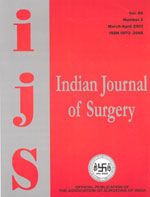
|
Indian Journal of Surgery
Medknow Publications on behalf of Association of Surgeons of India
ISSN: 0972-2068
Vol. 68, Num. 4, 2006, pp. 233-234
|
Indian Journal of Surgery, Vol. 68, No. 4, July-August, 2006, pp. 233-234
Letter To Editor
Color Doppler arteriography for lower limb arterial occlusive disease
Kapadia Sumit
Panchamrut Society, Behind TB Hospital, Gotri Road, Baroda -390 023 Gujarat
Correspondence Address:Panchamrut Society, Behind TB Hospital, Gotri Road, Baroda -390 023 Gujarat Email:
drsumit_k@rediffmail.com
Code Number: is06068
Sir,
The article by Thakur et al is interesting and thought-provoking.[1] I wish to highlight certain important issues regarding this topic.
- There have been many articles comparing duplex/triplex arterial mapping (Doppler arteriography) with conventional or magnetic resonance arteriography,[2],[3] which have shown good correlation. Color-Dopplers performed by vascular surgeons themselves have also found to be reliable and useful in strategic planning.[4] I consider that Doppler evaluation should be an integral part of a vascular surgeon′s practice.
- The phenomenon of false positive or negative occlusions is operator- as well as machine-dependent. Recent innovations to improve reliability include the use of contrast agents like Levovist during Doppler screening.[5] Pulse-generated run-off is another additional approach that is useful to demonstrate patent vessels.
- The authors state that the infra-popliteal region evaluation was not included in their study. The importance of assessing distal run-off in arterial occlusive disease is crucial for prognostic purposes in addition to strategic planning of revascularization procedures. Although the most difficult portion of a Doppler evaluation, it needs to be performed with great patience, also making use of additional measures like dependency of limb and power Doppler.
- For rapid screening purposes, common femoral artery velocity and spectral waveform have been considered for indirect assessment of severity of aorto-iliac inflow disease. A peak systolic velocity of less than 45 cm/s with a monophasic waveform is highly predictive of ipsilateral iliac artery occlusion.[6] Post-exercise duplex scanning has also been suggested to elicit a pressure decrease across a stenotic segment and improve the diagnostic utility of femoral Doppler scanning to estimate aorto-iliac disease.[7]
Taking into account these aspects, it is likely that high-quality triplex guided arterial mapping or Doppler angiography may be considered a safe alternative to conventional angiography for planning lower limb revascularizations, reserving the invasive angiography for complex multisegmental lesions or in presence of severe calcification.
References
| 1. | Thakur RS, Minhas SS, Dhiman DS, Abbey RK. Colour-flow doppler: An emerging alternative to conventional arteriography for arterial mapping in peripheral arterial occlusive disease. Indian J Surg 2006;68:17-22. Back to cited text no. 1 |
| 2. | Hingorani A, Ascher E, Markevich N, Kallakuri S, Schutzer R, Yorkovich W, et al . A comparison of magnetic resonance angiography, contrast arteriography and duplex arteriography for patients undergoing lower extremity revascularization. Ann Vasc Surg 2004;18:294-301. Back to cited text no. 2 |
| 3. | Katsamouris AN, Giannoukas AD, Tsetis D, Kostas T, Pertinarakis I, Gourtsyoyiannis N. Can ultrasound replace arteriography in the management of chronic arterial occlusive disease of the lower limb? Eur J Vasc Endovasc Surg 2001;21:155-9. Back to cited text no. 3 |
| 4. | Eisharawy M, Elzayat E. A fast arterial duplex ultrasound performed by vascular surgeons. Is the time now? Int Angiol 2002;21:374-8. Back to cited text no. 4 |
| 5. | Coffi SB, Ubbink DT, Zwiers I, van Gurp JA, Hanson D, Legemate DA. Contrast-enhanced duplex scanning of crural arteries by means of continuous infusion of Levovist. J Vasc Surg 2004;39:517-22. Back to cited text no. 5 [PUBMED] [FULLTEXT] |
| 6. | Shaalan WE, French-Sherry E, Castilla M, Lozanski L, Bassiouny HS. Reliability of common femoral artery hemodynamics in assessing the severity of aortoiliac inflow disease. J Vasc Surg 2003;37:960-9. Back to cited text no. 6 [PUBMED] [FULLTEXT] |
| 7. | Kapadia S, Grover T, Parakh R. Regarding Value of duplex waveform at the common femoral artery for diagnosing obstructive aortoiliac disease. J Vasc Surg 2006;43:428. Back to cited text no. 7 [PUBMED] [FULLTEXT] |
Copyright 2006 - Indian Journal of Surgery
|
